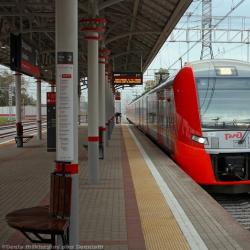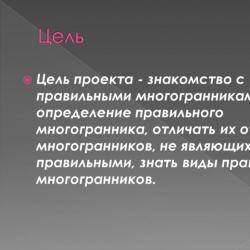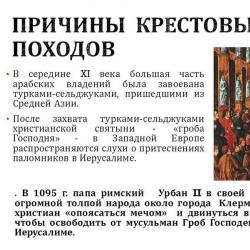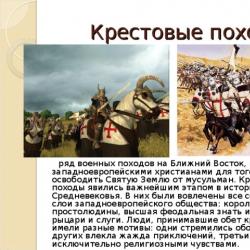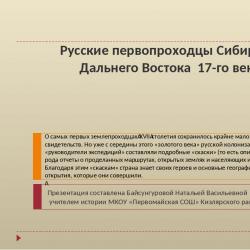Presentation on the First Crusade. Presentation on the theme "Crusades". Consequences of the Crusades
slide 2
3 crusade
The Third Crusade (1189-1192. Three of the most powerful took part in the Crusade: the German emperor Frederick I Barbarossa, the French king Philip II Augustus, and the English king Richard I the Lionheart. The Third Crusade was preceded by the capture of Jerusalem in October 1187.
slide 3
Richard I the Lionheart. Frederick I Barbarossa Philip II August,
slide 4
Richard the Lionheart
Richard I the Lionheart - April 6, 1199, Chalus, Duchy of Aquitaine - English king from the Plantagenet dynasty. Son of King Henry II of England and Duchess Eleanor of Aquitaine. He also had another nickname (not as well known as the Lionheart) - Richard Yes-and-No which meant that he was easily swayed one way or the other.
slide 5
Philip 2 August
Philip II August August 21, 1165 - July 14, 1223, Mantes) - King of France c1180, son of King Louis VII the Young and his third wife Adele of Champagne. The first king of France, who began to use the proper title "King of France" instead of the title "King of the Franks" and also the first of the Capetians, who transferred power to the heir without crowning him during his lifetime.
slide 6
Friedrich barbarossa
Friedrich I of Hohenstaufen - June 10, 1190. King of Germany from 1152, Emperor of the Holy Roman Empire from 1155, Duke of Swabia in 1147-1152 under the name Frederick III. He received the nickname Barbarossa in Italy because of his reddish beard (from Italian barba, “beard”, and rossa, “redhead”)
Slide 7
Frederick's death
It was an accident: while crossing a mountain river in Asia Minor, Barbarossa drowned, and part of the German troops returned home. English and French knights set out on a campaign only a year later. On the way, the British captured the island of Cyprus, from that time it became the stronghold of the crusaders. But Philip 2 August, having quarreled with the English king, returned to France
slide 2
“It happened immediately after Easter. We had not yet waited for the Trinity, as thousands of youths set off on their way, leaving their shelter. They chose feat and glory in Christ ... They forgot the cares entrusted to them. They left the plow with which they had recently blown up the earth; the Mohammedan heresy of the strong ... Having laid a cross on themselves and rallied under their banners, they moved to Jerusalem ... The whole world called them madmen, but they went forward "
slide 3
This is how David Baker describes the events of 1212 in his novel Paths of Tears. In history, this movement was called the "Children's Crusade".
slide 4
For quite some time, Europe has been anxiously learning about the events taking place in Palestine. Pilgrims returning from the Holy Land spoke about the persecution and insults that Christians were subjected to there after the capture of Jerusalem and the Holy Sepulcher
slide 5
slide 6
Gradually, a conviction arose of the need to help Christianity in the East and return to the Christian world its most precious and revered shrines. The crusades undertaken by the crusader knights were not successful, and in Europe, mainly among the peasantry, they started talking about the fact that only sinless children can liberate the Holy Land ... The initiators of the associations of children and adolescents for a trip to Jerusalem are the boys Stefan (according to some sources Shepherd Etienne) - in France and Nicholas - in Germany.
Slide 7
12-year-old Stefan declared himself "God's messenger" and went on preaching in the north of France, telling that the young and not vicious do not need weapons, Christ himself will give both food and victory, and the sea will part before them. Thousands of inspired children and adults joined Stephen, a huge army (about 30 thousand people) gathered and set off.
Slide 8
Slide 9
Slide 10
The participants of the campaign were dressed in simple gray shirts over short pants and large berets, each had a red, green or black cloth cross sewn on their chests. They walked with flags, banners, performing prayers and hymns.
slide 11
Children's Crusade. G. Dore
slide 12
The children first went to Paris, to King Philip II Augustus (the king ordered the children to go home, the priests persuaded them to abandon the campaign, but in vain ...), and then these detachments of commoner pilgrims reached Marseilles and boarded ships. Two of the seven ships were wrecked at sea, while the rest, instead of the Holy Land, arrived in Egypt, where the young pilgrims were sold into slavery. There is a version that this happened by prior conspiracy of merchant ship owners and Egyptian slave traders.
slide 13
PHILIP II AUGUST
Slide 14
No less tragic is the story of the German people's army, which, inspired by the speeches of the young preacher Nicholas (who was not even 10 years old, he traveled around South Rhine Germany on a huge cart and called for a campaign in the Holy Land ... These events may have formed the basis of the legend of the flutist - the rat-catcher, who took away all the children from the city of Gammeln), was heading to Italy through the Alps, then hoping to get to Palestine by sea. The number of troops was about 25 thousand people. In the most difficult transition from cold and hunger, about a third of the pilgrims died, those who decided to return halfway were more fortunate ...
In the middle of the XI century, most of the Arab possessions were conquered by the Turks - the Seljuks, who came from Central Asia. After the capture by the Turks - the Seljuks of the Christian shrine - the "Holy Sepulcher" - rumors spread in Western Europe about the oppression of pilgrims in Jerusalem .. In 1095, Pope Urban II, in his speech to a huge crowd of people near the city of Clermont, called on Christians to move to Palestine in order to liberate the Holy Sepulcher in the city of Jerusalem from the Muslims.

At the end of the XI century. Europe experienced famine and epidemics. The peasants dreamed of Palestine, wanting to get rid of their owners and get land. Landless knights were interested in oriental goods and dreamed of getting rich by plundering rich cities. The clergy wanted to extend their power to the East. "

Liberation of Palestine from the Seljuk Turks; the conversion to Christianity of the pagans of the Baltics; suppression of heretical movements in Europe (Cathars, Hussites, etc.). "Going to Palestine, the participants sewed red crosses on their chests, returning, they sewed it on their backs; hence the name "crusaders."


Clergy - expanding the sphere of influence, seizing lands Landless knights - seizing lands. Children - search for a home, because most of them were homeless. Peasants - the seizure of land for agriculture Knights - fame, money and the removal of sins. Violators of the law - shelter from punishment.

At the call of Peter the Hermit, the poor were the first to go on a campaign. They were unprepared, almost unarmed, but they believed that God would help them defeat their enemies and liberate Jerusalem. On the way, they begged for alms and often robbed the local population. The Byzantine emperor hurried to smuggle them to Asia, where in the first battle with the Turks, almost all of them were killed or captured. "

In the autumn of 1096, under the leadership of large feudal lords, detachments of knights from France, Germany and Italy set off on a campaign. Their detachments united in Constantinople, crossed into Asia Minor and defeated the Seljuk Turks in a decisive battle. On the way to Jerusalem, the crusaders captured and plundered cities, quarreled among themselves over booty. In 1099, after a month-long siege, the Crusaders stormed Jerusalem. Almost all of its Muslim inhabitants were killed. "

On the occupied lands - a narrow strip along the sea - the crusaders created several feudal states. The local population became dependent on the new land owners - European feudal lords. The main of them was considered the Kingdom of Jerusalem, the rulers of other crusader states were its vassals.


The orders were headed by the Grand Masters and they were subordinate only to the Pope. In the East, they helped pilgrims and protected them from Muslims, opened hospitals. Incoming donations and trade enriched the orders. Grand Master of the Knights Templar Grand Master of the Order of the Blessed Virgin Mary

The 2nd crusade, led by the French king Louis VII and the German king Conrad III, was organized after the conquest of Edessa by the Seljuks. It ended in a terrible defeat of the crusaders, who lost tens of thousands of dead and died of disease and hunger. "

At the end of the XII century, Muslims created a strong state. Its ruler Salah ad-Din (Saladin) managed to defeat the crusaders in several battles, the king of Jerusalem and the master of the Knights Templar were captured. In 1187, after a short siege, Saladin captured Jerusalem. Christian residents could leave the city for a ransom, those who could not pay the ransom were sold into slavery (15 thousand people). "

For the return of Jerusalem, the Third Crusade was organized. Emperor Frederick I Barbarossa, who led the German knights, died in Asia Minor, and his army returned home. The French and English knights, led by Kings Philip II Augustus and Richard I the Lionheart, acted inconsistently. Having not achieved success, the French knights, led by the king, returned home. Philip II Augustus and Richard the Lionheart

Richard the Lionheart managed to recapture the city of Acre (which became the capital of the Kingdom of Jerusalem), but there were not enough troops to capture Jerusalem from the British and the knights of various orders who supported him. On his way to England, Richard the Lionheart was captured by his enemy the Duke of Austria and spent two years in captivity. He was released for a large ransom. "

Pope Innocent III organized the Fourth Crusade. The Crusaders were supposed to land in Egypt, but the Venetian ruler (Doge) demanded a huge amount for transportation and the knights could not pay it. The Venetians persuaded the crusaders to capture the Christian city of Constantinople. In 1204 Constantinople was stormed and plundered. The campaign against Jerusalem did not take place. On the territory of Byzantium, the crusaders created the Latin Empire. "

In France, in 1212, a new Crusade began, in which only children took part, in order to liberate Jerusalem without weapons with the name of God on their lips. 25 thousand children from all over Europe came to Italy. There they were put on ships and taken to Africa, sold into slavery. "


"The campaigns brought misfortune to the inhabitants of the eastern countries and ruin for the inhabitants of Europe. But having paved the way to the East, the knights contributed to the development of trade. Europeans took a lot in the East - silk and glass, rice and buckwheat, lemons and sugar, watermelons and apricots. The life of Europeans has also changed - they began to observe hygiene, wash in baths, change linen and clothes.Feudal lords began to strive for luxury, and this required money, so commodity-money relations began to develop rapidly in Europe.

slide 1
"slide 2
 Speech by Pope Urban II at the Council of Clermont (1095) To all who go there, in the event of their death on a dry path or at sea, or in battle with the filthy, from now on there will be an absolution of sins ... Let them oppose the infidels in battle ... The land that you inhabit, squeezed from everywhere by the sea and mountain ranges with riches, it is not abundant ... That land flows with honey and milk. Jerusalem is the most fruitful pearl of the earth, the second paradise of comfort ... "
Speech by Pope Urban II at the Council of Clermont (1095) To all who go there, in the event of their death on a dry path or at sea, or in battle with the filthy, from now on there will be an absolution of sins ... Let them oppose the infidels in battle ... The land that you inhabit, squeezed from everywhere by the sea and mountain ranges with riches, it is not abundant ... That land flows with honey and milk. Jerusalem is the most fruitful pearl of the earth, the second paradise of comfort ... "
slide 3
 The Crusades are a series of military campaigns by Western European knights directed against the "infidels" (Muslims, pagans, Orthodox states and various heretical movements). "
The Crusades are a series of military campaigns by Western European knights directed against the "infidels" (Muslims, pagans, Orthodox states and various heretical movements). "
slide 4
 The goal is the liberation of Palestine from the Seljuk Turks; the conversion to Christianity of the pagans of the Baltics; suppression of heretical movements in Europe (Cathars, Hussites, etc.). "
The goal is the liberation of Palestine from the Seljuk Turks; the conversion to Christianity of the pagans of the Baltics; suppression of heretical movements in Europe (Cathars, Hussites, etc.). "
slide 5
 Departing for Palestine, the participants sewed red crosses on their chests, returning, they sewed it on their backs; hence the name "crusaders". "
Departing for Palestine, the participants sewed red crosses on their chests, returning, they sewed it on their backs; hence the name "crusaders". "
slide 6

Slide 7
 The goals of the participants of campaigns Clergy - to expand the spheres of influence, the seizure of lands Landless knights - the seizure of lands. Children - find a home, because. most of them were homeless. Peasants - the seizure of land for agriculture Knights - glory, money and the removal of sins. Violators of the law - shelter from punishment. "
The goals of the participants of campaigns Clergy - to expand the spheres of influence, the seizure of lands Landless knights - the seizure of lands. Children - find a home, because. most of them were homeless. Peasants - the seizure of land for agriculture Knights - glory, money and the removal of sins. Violators of the law - shelter from punishment. "
Slide 8
 Peasant Crusade (1096) In mid-March 1096, crowds of peasants (about 60-70 thousand people), led by the ascetic preacher Peter the Hermit, set off on a campaign without waiting for the knights to gather. They passed along the valleys of the Rhine and Danube, crossed Hungary and in the summer of 1096 reached the limits of the Byzantine Empire; their path was marked by robberies and violence against the local population and Jewish pogroms. "
Peasant Crusade (1096) In mid-March 1096, crowds of peasants (about 60-70 thousand people), led by the ascetic preacher Peter the Hermit, set off on a campaign without waiting for the knights to gather. They passed along the valleys of the Rhine and Danube, crossed Hungary and in the summer of 1096 reached the limits of the Byzantine Empire; their path was marked by robberies and violence against the local population and Jewish pogroms. "
Slide 9
 In July, the significantly thinned (almost halved) militia of the crusader peasants approached Constantinople. The Byzantines hastily transported him across the Bosporus to the town of Tsibotus. Against the advice of Peter the Hermit, peasant detachments moved to Nicaea, the capital of the Seljuk state. On October 21, they fell into an ambush set up by Sultan Kylych-Arslan I, and were utterly defeated; most of the crusader peasants died (about 25 thousand people). "
In July, the significantly thinned (almost halved) militia of the crusader peasants approached Constantinople. The Byzantines hastily transported him across the Bosporus to the town of Tsibotus. Against the advice of Peter the Hermit, peasant detachments moved to Nicaea, the capital of the Seljuk state. On October 21, they fell into an ambush set up by Sultan Kylych-Arslan I, and were utterly defeated; most of the crusader peasants died (about 25 thousand people). "
slide 10
 1st Crusade (1097-1099) The 1st Crusade, led by Duke Gottfried of Bouillon, Count Raymond of Toulouse, Duke Bohemond of Tarentum and his nephew Tancred, Duke Robert of Normandy and Count Robert of Flanders, was the most successful and ended with the conquest of Palestine and the liberation of Jerusalem from the Muslims. "
1st Crusade (1097-1099) The 1st Crusade, led by Duke Gottfried of Bouillon, Count Raymond of Toulouse, Duke Bohemond of Tarentum and his nephew Tancred, Duke Robert of Normandy and Count Robert of Flanders, was the most successful and ended with the conquest of Palestine and the liberation of Jerusalem from the Muslims. "
slide 11
 2nd Crusade (1147-1149) The 2nd Crusade, led by the French king Louis VII and the German king Conrad III, was organized after the conquest of Edessa by the Selduks. It ended in a terrible defeat of the crusaders, who lost tens of thousands of dead and died of disease and hunger. "
2nd Crusade (1147-1149) The 2nd Crusade, led by the French king Louis VII and the German king Conrad III, was organized after the conquest of Edessa by the Selduks. It ended in a terrible defeat of the crusaders, who lost tens of thousands of dead and died of disease and hunger. "
slide 12
 3rd Crusade (1189-1192) The 3rd Crusade began after the Egyptian sultan Salah ad-din (Saladin) conquered Jerusalem. The campaign was led by the German emperor Frederick I Barbarossa, the French king Philip II and the English king Richard I the Lionheart. The victories of Richard the Lionheart extended the existence of crusader states in Palestine, but Jerusalem could not be liberated. "
3rd Crusade (1189-1192) The 3rd Crusade began after the Egyptian sultan Salah ad-din (Saladin) conquered Jerusalem. The campaign was led by the German emperor Frederick I Barbarossa, the French king Philip II and the English king Richard I the Lionheart. The victories of Richard the Lionheart extended the existence of crusader states in Palestine, but Jerusalem could not be liberated. "
slide 13
 4th crusade (1199-1204) The 4th crusade was organized to attack Egypt - the basis of Arab power. A victory in Egypt could rid the Holy Land of the Muslim threat. However, Venice took advantage of the situation to send the crusaders not to Egypt, but to Byzantium, the hatred of which in Europe had long been equal to the hatred of the Saracens. In 1202, the crusaders took Constantinople, and the European territories of the Byzantine Empire were divided among the European feudal lords. In its place, the Latin Empire arose, which lasted until 1261, when the Greeks regained Constantinople. "
4th crusade (1199-1204) The 4th crusade was organized to attack Egypt - the basis of Arab power. A victory in Egypt could rid the Holy Land of the Muslim threat. However, Venice took advantage of the situation to send the crusaders not to Egypt, but to Byzantium, the hatred of which in Europe had long been equal to the hatred of the Saracens. In 1202, the crusaders took Constantinople, and the European territories of the Byzantine Empire were divided among the European feudal lords. In its place, the Latin Empire arose, which lasted until 1261, when the Greeks regained Constantinople. "
slide 14
 "
"
slide 15
 "Children's Crusade" 1212 Thousands of French and German children decided to liberate Jerusalem on their own. Almost all of them disappeared, died or were sold into slavery to Muslims by their own fellow believers. "
"Children's Crusade" 1212 Thousands of French and German children decided to liberate Jerusalem on their own. Almost all of them disappeared, died or were sold into slavery to Muslims by their own fellow believers. "
slide 16
 5th Crusade (1217-1221) The 5th Crusade was aimed at attacking Egypt. It was preceded by the "Children's Crusade". The Austrian Duke Leopold VI and King Andras II of Hungary took part in the campaign. The Muslims were alarmed by the preparations of the crusaders and entered into negotiations, offering to give up Jerusalem. But their very lucrative offers were rejected. Soon the crusaders became victims of the ambitions of their leaders and the waters of the Nile, which overflowed its banks and flooded their camp. The campaign ended in failure. "
5th Crusade (1217-1221) The 5th Crusade was aimed at attacking Egypt. It was preceded by the "Children's Crusade". The Austrian Duke Leopold VI and King Andras II of Hungary took part in the campaign. The Muslims were alarmed by the preparations of the crusaders and entered into negotiations, offering to give up Jerusalem. But their very lucrative offers were rejected. Soon the crusaders became victims of the ambitions of their leaders and the waters of the Nile, which overflowed its banks and flooded their camp. The campaign ended in failure. "
slide 17
 6th Crusade (1228-1229) The 6th Crusade was led by Holy Roman Emperor Frederick II Hohenstaufen. Frederick achieved his goal not by war, but by diplomacy: he managed to negotiate with the Muslims and conclude an agreement under which they gave him Jerusalem, because they did not want to fight the crusaders in the face of a new formidable enemy - the Tatar-Mongols. Success was relative: in 1244, the Muslims again captured Jerusalem. "
6th Crusade (1228-1229) The 6th Crusade was led by Holy Roman Emperor Frederick II Hohenstaufen. Frederick achieved his goal not by war, but by diplomacy: he managed to negotiate with the Muslims and conclude an agreement under which they gave him Jerusalem, because they did not want to fight the crusaders in the face of a new formidable enemy - the Tatar-Mongols. Success was relative: in 1244, the Muslims again captured Jerusalem. "
slide 18
 7th Crusade (1248-1254) The 7th Crusade was organized and led by King Louis IX of France (1215-1270). The situation in the Holy Land was critical, the crusader states in Palestine hung in the balance. In August 1248, he went to Egypt at the head of a fleet of hundreds of ships with 35,000 troops. His goal was simple: to land in Egypt, capture the main cities of the country and then exchange their Muslim territories in the Holy Land. Initially, he was successful. Capturing the fortified port city of Damietta, he launched an offensive against Cairo. "
7th Crusade (1248-1254) The 7th Crusade was organized and led by King Louis IX of France (1215-1270). The situation in the Holy Land was critical, the crusader states in Palestine hung in the balance. In August 1248, he went to Egypt at the head of a fleet of hundreds of ships with 35,000 troops. His goal was simple: to land in Egypt, capture the main cities of the country and then exchange their Muslim territories in the Holy Land. Initially, he was successful. Capturing the fortified port city of Damietta, he launched an offensive against Cairo. "
slide 19
 The months-long siege of the fortress ended in disaster. The Muslims defeated the crusaders, burned the fleet that supplied them with food, in addition, an epidemic of pestilence began in the crusader camp, as the waters of the Nile carried past thousands of bloated corpses. The case perished, and Louis, himself infected with the disease, had to retreat to Damietta, but was captured along with the miserable remnants of his army, for the release of which he had to pay a huge ransom. "
The months-long siege of the fortress ended in disaster. The Muslims defeated the crusaders, burned the fleet that supplied them with food, in addition, an epidemic of pestilence began in the crusader camp, as the waters of the Nile carried past thousands of bloated corpses. The case perished, and Louis, himself infected with the disease, had to retreat to Damietta, but was captured along with the miserable remnants of his army, for the release of which he had to pay a huge ransom. "
slide 20
 8th Crusade (1270) The 8th Crusade was also organized by Louis IX. In early July, the crusaders landed in Sardinia. There, under pressure from the king's brother Charles, they decided to go to Tunisia, with whose emir he was at enmity. On July 18, the crusaders landed in Africa and fought their way to ancient Carthage. But due to delays, the chance to win was missed. Due to the large crowding in the camp, a pestilence began, the son of the king died, and soon Louis himself fell ill. On August 25, he died, after which the crusaders returned to Europe. The era of the Crusades is over. "
8th Crusade (1270) The 8th Crusade was also organized by Louis IX. In early July, the crusaders landed in Sardinia. There, under pressure from the king's brother Charles, they decided to go to Tunisia, with whose emir he was at enmity. On July 18, the crusaders landed in Africa and fought their way to ancient Carthage. But due to delays, the chance to win was missed. Due to the large crowding in the camp, a pestilence began, the son of the king died, and soon Louis himself fell ill. On August 25, he died, after which the crusaders returned to Europe. The era of the Crusades is over. "
Choose the correct answer- The knights belonged to… Heretics were opponents The church punished heretics The mendicant monastic order was the 1st estate 2nd estate 3rd estate The official church of the royal power Separation of churches Fines Excommunication from the church Hard labor Sword-bearers Franciscans Crusaders




1. The beginning of the crusades. In 1095, the Pope of Rome spoke in Clermont. He called to go to the East, to free the tomb of the Lord from the hands of the infidels. The participants of the campaign received absolution. The path of the knights, dressed in cloaks with crosses, lay in Palestine, where Jesus Christ was buried in Jerusalem. Ecumenical Council of 1095

In the 11th century, Europe was experiencing famine and epidemics. The peasants did not go to Palestine, wanting to get rid of their masters. The landless knights were interested in oriental goods and dreamed of robbing rich cities. current. 2. Participants of hikes. Crusades.

In the spring of 1096, the poor, led by knights, went on a campaign. They were poorly armed and had no food supplies. With great losses they reached Constantinople and plundered it. The emperor sent them to Asia Minor, where they were killed by the Seljuk Turks. 3. Hike of the poor. The poor on the march.

In the autumn of 1096, detachments of knights set off from France and Germany to the East. Having united in Constantinople, they soon defeated the Turks and began to plunder the cities. Many knights remained in the conquered lands. In 1099, the knights approached Jerusalem and, after a month-long siege, took the city. 4. Campaign of the feudal lords. The sack of Jerusalem. Medieval miniature.

Crusader states formed on the eastern coast of the Mediterranean Sea. In the Kingdom of Jerusalem, the knights enslaved both Muslims and Christians. The church owned vast estates here. The population paid the taxes of the king and the tithe of the church. 5. The state of the crusaders. The center of the kingdom was the Church of the Holy Sepulcher. The knights served to protect this huge building, which was of great importance for all Christians. Several dozen monasteries, bishoprics and abbeys were created around Jerusalem.

For the defense of possessions, the crusaders began to create the Knights Templar, Hospitallers, Teutons. The Templars (templars) had a residence on the site of the destroyed Jewish temple. The Hospitallers opened hospitals for pilgrims. The Order was headed by the Grand Masters. 6.Spiritual and chivalrous orders Members of these orders were forbidden secular entertainment. The orders received benefits from the popes - they did not pay tithe, they received judgment only from the popes, they collected generous donations. The orders quickly gained strength and began to wage wars with neighboring states and with each other. Knight Templar and Knight Hospitaller.


